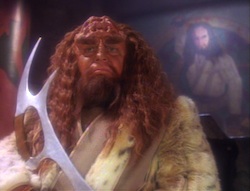“Rightful Heir”
Written by James E. Brooks and Ronald D. Moore
Directed by Winrich Kolbe
Season 6, Episode 23
Production episode 40276-249
Original air date: May 17, 1993
Stardate: 46852.2
Captain’s Log: Worf, who is only not the most punctual person on the ship by virtue of Data being on board, is late for alpha shift. Riker calls Worf, but he doesn’t answer, though the computer registers him as being in his quarters. Heading there with a security team, Riker finds Worf’s quarters steamy, filled with candles, a large brazier filled with scalding rocks heating the room. Worf is very obviously in a trance, and possibly high as a kite.
Later, Picard goes to Worf’s quarters, pissed. His personal issues have interfered with his duty to the Enterprise, and Picard justifiably wants to know why. Worf tries the “It is difficult to explain” excuse, which doesn’t fly, and Worf finally admits that he’s felt empty since returning from the Carraya system. He tells Picard that the children he rescued knew nothing of their heritage (true, as far as it goes) and so he taught them, including telling them stories about Kahless and how he promised to return some day. He wants to recapture the wonder the children felt when Worf told the stories of Sto-Vo-Kor, where Kahless awaits the honored dead, so he tried to summon a vision of Kahless.
Staring at the brazier, Picard dryly says he should’ve used the holodeck instead of risking setting fire to his cabin, but Worf insists it all must be real if he were to summon a true vision. But it was for naught—he did not see Kahless.
Picard suggests that he must immerse himself in Klingon beliefs to see if they still hold strongly for him. With Picard’s blessing, he takes leave and travels to the monastery on Boreth, where clerics await Kahless’s return. (Picard also makes it clear that he’d better have his crap together when he gets back.)
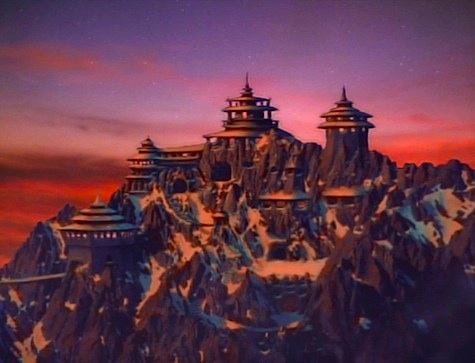
We cut to Worf on Boreth, sitting around a brazier with a bunch of other folks, hoping for a vision of Kahless. He’s been there for ten days. However, Divok, a nineteen-year-old kid, sees a vision of Kahless. Angrily, Worf returns to his rooms and starts packing. The head cleric, Koroth, asks him why he’s leaving, and Worf frustratedly explains that he’s had no visions, no insight, nothing.
Koroth asks him to tell the Story of the Promise. Worf recites it rotely: after uniting the Klingon people and giving them the laws of honor, Kahless saw that his work was done, so he packed his bags and went to the edge of the city. The people wept, not wanting him to go. Kahless said that Klingons need no one but themselves. He was going to Sto-Vo-Kor, but he would one day return. He pointed to a star and said he would return there; that star was Boreth. Koroth says it’s been fifteen centuries since he made that promise; what is ten days in the life of one Klingon compared to that?
This, Koroth explains, is a place of questions, not answers. He encourages Worf to open his mind, unclutter the doubts, and seek out Kahless’s wisdom. Worf and Divok again sit at the brazier—and Kahless appears. But it’s not a vision, it’s a physical presence, a person who announces that he is Kahless and he has returned.
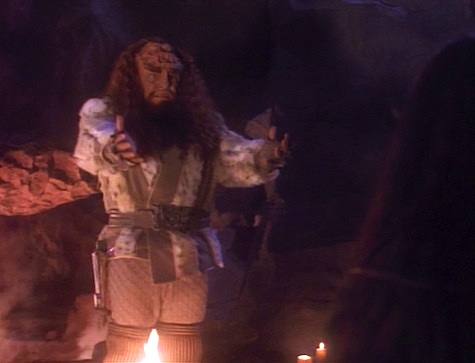
The monastery is, for obvious reasons, abuzz. Koroth voices skepticism, and is angry when Kahless removes the bat’leth from the shrine. (Right over that shrine is a painting of Kahless that looks just like this guy.) Kahless asks how the bat’leth was first forged, and one of the monks says that no one knows. That story was never told, never recorded. Kahless says that he used a lock of his hair and thrust it into the river of molten rock from the volcano of Kri’stak, then cooled it in the Lake of Lusor and twisted it into the familiar shape. He used it to kill Molor and then named it bat’leth—the sword of honor.
Koroth is overcome. That story is known only to the high clerics, to be used to be sure that Kahless has truly returned. Kahless says he has come back because the Klingon people have lost their way in petty wars and squabbles among themselves. Koroth kneels before Kahless, and soon so does everyone else—except Worf. He retrieves his tricorder and scans Kahless with it; he really is a Klingon. When Kahless asks what else he could be, Worf points out several possibilities that we’ve seen in other Star Trek episodes like a shapeshifter or a holographic projection (Crusher will later bring up some other possibilities, from mundane notions like surgical alteration to more outlandish ones like a coalescent being). Kahless then explains how he knows Worf’s name: the vision Worf had when he was a child at No’Mat (that he and Data discussed in “Birthright, Part I”), in which Kahless told him he’d do something no Klingon has ever done before. (Which came true, as he became the first Klingon to join Starfleet.) Kahless asks if he believes now, and Worf can only say that he wants to. That, Kahless says, is a good start.
Three days pass. One monk expresses concern about Gowron, which Kahless dismisses, as all Klingons will flock to his banner, he’s sure of it. Worf remains skeptical. Kahless wonders if all he can do is ask questions. When Worf points out that questions are the beginning of wisdom, Kahless reminds him that a leader need not answer questions of those who follow. Worf points out that that’s only true if the leader is worthy of that trust. That leads, naturally, to a bat’leth duel. It doesn’t really end, as Kahless suddenly starts laughing. After all, they don’t just fight for bloodlust, but to enrich the spirit. It’s a good rallying cry, and also cleverly disguises the fact that Worf actually was winning the fight (this will be important later). Soon they’re all chanting “We are Klingons!” at the top of their lungs—again, except for Worf.
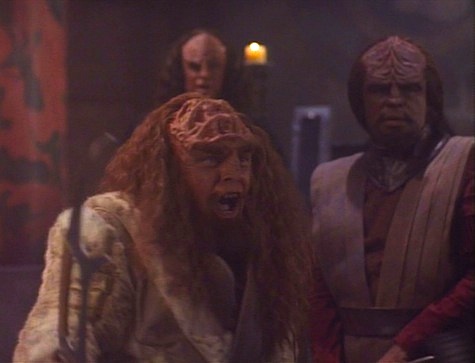
The Enterprise has been sent to Boreth to escort Kahless from the monastery to the Klingon homeworld, thus saving Worf a trip back to the ship. Data queries Worf about Kahless, asking for insights about faith, but Worf blows him off. Then the Enterprise rendezvouses with Gowron’s flagship, and the chancellor beams on board. He specifically requested the Enterprise because he doesn’t want Kahless to spread his lies to a ship of loyal Klingons. Gowron is convinced that this is an impostor, and he needs to nip the notion of Kahless’s return in the bud.
Gowron has brought a knife that is stained with Kahless’s blood. Koroth is disgusted that Gowron—whom he dismisses as someone whose days are numbered—would violate tradition by removing the knife from the sacred vault. However, Kahless does agree to allow Crusher to compare the blood to a biological sample from him to see if they match.
To everyone’s surprise, the DNA is a perfect match.
Worf shares a drink with Kahless, where he tells Worf that it was his purity of spirit that brought him back. Kahless wants Worf—who has respect not only in the empire, but also in the Federation—to be by his side.
But when Worf brings Kahless’s notions to Gowron, the chancellor rejects it. It will lead to civil war. There are already lines being drawn on Gowron’s own ship—those who believe it is Kahless versus those who believe him an impostor. Gowron is also convinced that this whole thing is a ploy on Koroth’s part to grab power. Gowron asks Worf to renounce Kahless and stand with him as he did against Lursa and B’Etor. Worf refuses, but asks Gowron to listen to Kahless, to give him a chance to lift his spirit and cleanse his heart.
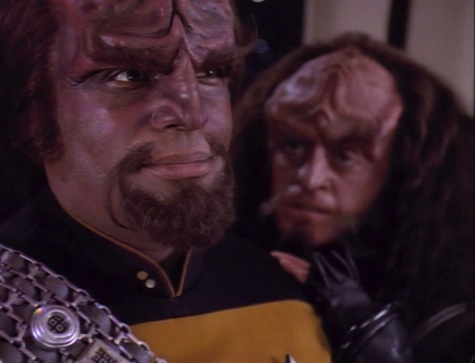
Kahless’s shrine has been re-created on the Enterprise holodeck. Gowron goes there to speak to Kahless—after snarking Koroth a bit. Kahless tells a story about a man who refused to evacuate the city of Quin’lat when a storm approached. When the storm came he was killed, for the wind does not respect a fool. Gowron thinks it’s a lovely story, but wonders what the man’s name was. How tall was he? What was he wearing? What color were his eyes? Kahless lamely replies that he doesn’t remember, and then starts spouting platitudes again.
Then, of course, they duel. Because, y’know, Klingons. And Gowron kicks his ass. Worf keeps Gowron from killing him, but the damage is done, as Gowron laughs derisively at the defeat of “the greatest warrior of all.”
Koroth immediately goes into damage-control mode, but he’s got two roadblocks. One is Kahless himself, who can’t believe that he lost the fight so badly. The other is Worf, who has come to realize that Gowron was right, that this isn’t Kahless.
Finally, Koroth admits the truth. This is a clone of the original Kahless, given the memories of Kahless as recorded in the sacred texts. Worf is disgusted, but Koroth says this could be how the prophecy was meant to be fulfilled. Who is to say that what they did was wrong?
Worf’s response is blunt as ever: “I am.” Koroth says that even if he’s just a clone, he’s the last hope for the Klingon people. Worf then goes to the holodeck, where two of Gowron’s warriors sit and await Kahless’s return. Data is there, also, explaining to Worf that they still believe in Kahless even though Gowron defeated him. Worf declares them to be fools, and Data wonders if Worf no longer believes the real Kahless will return. Worf is wondering the same thing, and Data then tells him that he once had a kind of crisis of faith. He was told when he was activated that he was only a machine, but he chose to believe that he was a person, that he had the potential to be more than a collection of circuits and subprocessors. He made a leap of faith.
Gowron, Kahless, Worf, and Koroth gather in the observation lounge. Worf tells Gowron the truth about Kahless—but also that it doesn’t matter. As Gowron himself said before, the idea of Kahless has taken root. And he can still be a force for good in the empire. There are Klingons who will make a leap of faith and still believe in Kahless despite the truth of his nature. And if Gowron opposes him, it will indeed lead to civil war. Gowron refuses to turn the empire over to a clone, but that’s not what Worf is suggesting. He proposes that Kahless be the moral leader of the empire as emperor—political leadership will remain with the High Council, but Kahless will have the ability to mold the Klingon heart, to lead by example. Koroth doesn’t like the idea because he’ll just be a figurehead, and Gowron points out that there hasn’t been an emperor for three centuries, but Worf says that if they don’t go along, it will mean civil war. And Worf will lead it.
Kahless accepts Worf’s challenge. Koroth kneels before him, as does Worf. Gowron is skeptical, but Kahless urges him to join him, to let them usher in a new era together. Finally, Gowron agrees, and kneels before him.
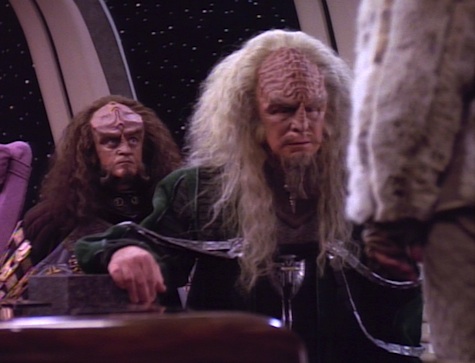
Worf sees Kahless off. Worf is back to being down-in-the-dumps, but Kahless points out that it doesn’t matter if Kahless really does return; what matters is that Klingons continue to follow his teachings.
Can’t We Just Reverse the Polarity?: The clerics on Boreth not only created a clone, but also were able to accelerate his growth and imprint memories based on the sacred texts into his mind. He only remembers what’s in the texts, though, and they couldn’t program him how to fight particularly well.
If I Only Had a Brain…: Data reveals that he once had a crisis of faith and then had to make a leap of faith, something neither Worf nor the viewers would have credited him with. Yet it makes sense, as he explains: he had to believe that he could grow and change and become more than just a machine.
There is No Honor in Being Pummeled: Worf’s influence on Klingon politics remains strong. His support was crucial to Gowron’s victory in “Redemption II,” and now he installs an emperor. Both sides of this conflict try to recruit him, Gowron openly calling upon his loyalty and past support, Koroth more subtly by having it be Worf to whom Kahless first manifests.
I Believe I Said That: “You have no joy, Gowron! Is your heart so filled of distrust and suspicion that you’ve forgotten what it is to be truly Klingon?”
The last thing Kahless says before Gowron knocks him on his ass.
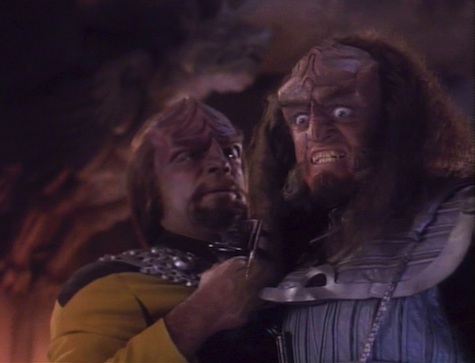
Welcome Aboard: A superb trio of guests in this one. Robert O’Reilly returns for his final TNG appearance as Gowron (following “Reunion,” “Redemption,” and “Redemption II”); he’ll move over to Deep Space Nine, appearing next in “The House of Quark,” and continuing to recur for the rest of that show’s run. Two veteran character actors play Koroth and Kahless: Allan Oppenheimer and Kevin Conway, who are both brilliant. Oppenheimer will return on DS9’s “The Jem’Hadar” as Captain Keogh and on Voyager’s “Rise” as the Nezu ambassador.
Trivial Matters: This episode continues the Klingon political arc begun in “Sins of the Father,” and concludes the TNG portion of it. DS9 will pick it up with “The Way of the Warrior,” not coincidentally the episode that brings Worf into DS9’s cast, and continue it through to the end.
Also, this story follows up on what Worf went through in “Birthright, Part II,” explicitly referencing the events of that episode and its effect on Worf.
Technically, this is the second appearance of Kahless, having been played by Robert Herron in “The Savage Curtain” on the original series. That Kahless had a smooth head, and all we really knew about him was that he was important to Klingon history and he could do a damn fine Surak impersonation. Since that Kahless was a creation based on Captain Kirk’s thoughts, its inaccuracy can be chalked up to Kirk not really knowing all that much about him.
While Kahless will not be seen again onscreen, he is mentioned several times, mostly on Deep Space Nine when Klingon stuff comes up: “The Way of the Warrior,” “Sons of Mogh,” and “The Sword of Kahless.” However, he is never mentioned during the Dominion War. The character continues to appear in novels taking place after DS9’s finale, including the two-book series The Left Hand of Destiny by J.G. Hertzler & Jeffrey Lang, several post-finale Voyager novels by Christie Golden and Kirsten Beyer, and in A Time for War, a Time for Peace by your humble rewatcher, after which he stepped down from his position of emperor. Kahless’s life was detailed (and some myths debunked) in Michael Jan Friedman’s Kahless.
Make it So: “Vorcha doh baghk Kahless!” I adore this episode so much, because it finally brought religion to Star Trek. The spirituality of the Klingons is something I’ve always found fascinating, and this episode opened the door to exploring it more fully (though a lot of that happened on DS9, particularly in a brilliant scene in “Rapture” involving Worf, Kira, Dax, and O’Brien, with the former two extolling the virtues of faith, the latter two preferring rationalism, and both sides making strong arguments).
And yes, I’m a total agnostic and rationalist, but I’ve always been interested in religious studies (blame the Jesuits at Fordham University), because it’s such a critical component of human behavior throughout history. The humans of Gene Roddenberry’s future don’t really do religion, but here with Klingons, and later with Bajorans, Trek can examine issues of faith.
Klingon faith is actually more appealing to me now than it was then, too, because it’s a similar type of spirituality that you see in martial artists (which I’ve been a student of since 2004). Kahless’s speech after his and Worf’s abortive sparring espouses the notion of taking joy in the thrill of combat, the enriching of the spirit through physical activity, through risking your life over a point of honor.
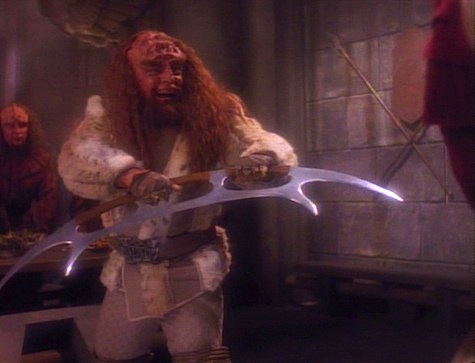
Even if you take all that out of it, though, this is still a great episode. Worf has always been the ideal Klingon, but exposure to the day-to-day realities of Klingon life (“Sins of the Father,” “Reunion,” “Redemption,” “Redemption II”) has soured him on it, and then he meets Toq and Ba’el and the others in “Birthright, Part II,” and they have that same purity of purpose that he had before he had to accept discommendation and get involved in civil wars and all that other fun stuff.
And if you don’t care about Worf’s character development, there’s some fun political stuff. Koroth is a master manipulator here, keeping Kahless front and center, even playing the doubter when he first appears before being “convinced.” All of it is in service of putting Kahless in charge of the government, with Koroth, of course, as his chief advisor. Gowron, meanwhile, sees Koroth’s hand in it from jump—so much so that he can’t see that, to a degree, the cleric has been successful.
In the end, the character we learn most about besides Worf is Data, in his conversation with Worf on the holodeck. Some of TNG’s finest moments have been when these two have been put together (most recently in “Birthright, Part I”), and this episode has one of the finest, as Data reveals that he had to have faith in order to accept what he could become over what he was. Worf is shocked at the very notion of Data having such a crisis, but it makes perfect sense, even within the framework of Data’s hyperrationalism.
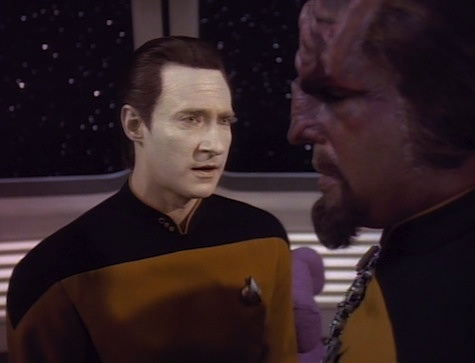
Plus it gives Worf the inspiration for the latest in a series of Worf’s last-minute brilliant solutions to the seemingly insoluble (cf. “The Emissary,” “Sins of the Father”), which is a very elegant untying of the Gordian knot of Gowron vs. Koroth. It helps that Michael Dorn, Brent Spiner, Allan Oppenheimer, Robert O’Reilly, and especially Kevin Conway each turn in simply dazzling performances. Conway in particular is convincingly messianic, and also convincingly fake, in that every line of dialogue out of his mouth sounds like a religious tract (which is, of course, what his brain is made of). Oppenheimer is subtle and strong, while O’Reilly continues to sneer magnificently as Gowron. His speech to Picard about the difficulty in fighting an idea is particularly well delivered, and his picking apart of Kahless’s story of the man at Quin’lat is beautifully done.
Just a great episode, exactly what you’d expect from TNG’s best writer and best director in Winrich Kolbe.
Warp factor rating: 10
Keith R.A. DeCandido is going to be at Flora in Arlington, Massachusetts on Tuesday the 11th of December at 6pm for the east coast launch of Tales from the House Band Volume 2, an anthology from Plus One Press that includes his story “I Believe I’m Sinkin’ Down.” He’ll be joined by fellow contributors Clea Simon, Brett Milano, and Dave Brigham. Come check it out!










